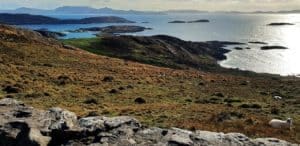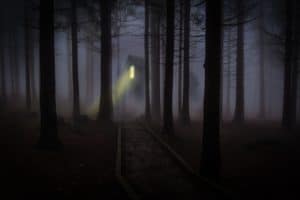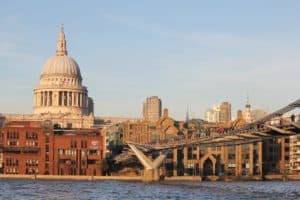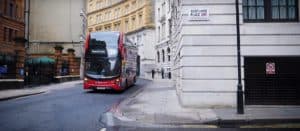Irish Castles: Where History and Paranormal Activity Combine
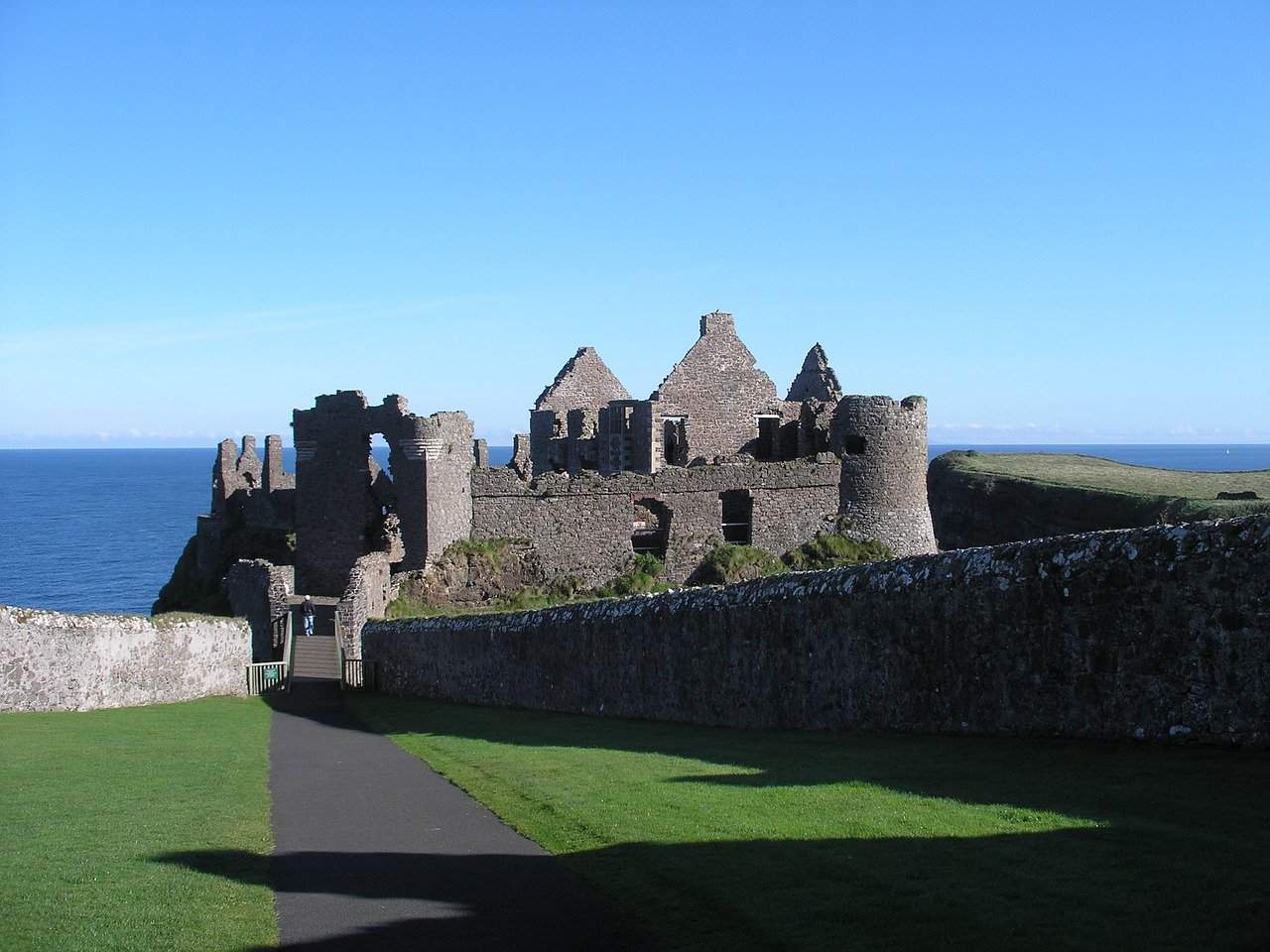
Updated On: April 22, 2024 by Dina Essawy
Irish Castles are a perfect representation of the country’s long history. Every corner of Northern Ireland or the Republic of Ireland has historical buildings and discoveries representing the region’s long-standing culture.
Now, it is time to list all the Irish castles and give you some insight into their history.
Table of Contents
The Most Famous Irish Castles
Dundrum Castle
Dundrum Castle is located in the town of County Down, Northern Ireland. It was constructed by John de Courcy near the beginning of the 13th century, following his invasion of Ulster. The castle stands on the top of a rocky hill, commanding fine views south over Dundrum Bay and the Mourne Mountains, the lands west towards Slieve Croob and the plains of Lecale to the east. The Irish Castle is a State Care Historic Monument in the townland of Dundrum, in Newry, Mourne and Down District Council area.
Dundrum Castle was first referenced in the mid-13th-century Chronicle of Mann, which mentions de Courcy’s unsuccessful attempt to siege “the castle of Rath” in 1205. The castle was captured by King John in 1210. Most of the second floor of this keep was rebuilt in the 15th century.
After 1660, the Blundells returned and built a gabled L-shaped mansion, ruined by the time the property passed to the second Marquess of Downshire in the early 19th Century.
Dundrum Castle was built on the site of a previous Celtic fortification. It saw plenty of battles until the 17th Century. Dundrum Castle is one of the more important medieval castles in Ireland.
Dundrum Castle is an essential example of Norman architecture and is a regular destination for tourists and school children. The castle is now part of the Game of Thrones Tour, as some scenes were shot there to depict Winterfell.
Enjoy Dundrum Castle and the surrounding historical sites and landscapes for a full-on experience.
Ballygally Castle
Ireland is no stranger to haunted houses and castles, and there are a frightening number of ghost stories about them. Ballygally Castle Hotel in County Antrim is a prime example of a haunted dwelling. Over the years, the castle’s residents and guests have reported numerous paranormal activity and sightings reports. Here’s how it all began.
Ballygally Castle was transformed into a hotel in the 1950s. The Irish castle was built in 1625 by James Shaw of Scotland in a French chateau style after renting the land from the Earl of Antrim. Shaw first came to Ireland in 1613.
The castle unsuccessfully came under attack several times during the rebellion of 1641 from the Irish garrison at Glenarm.
The story of the ghosts that roam Ballygally Castle originates with Lady Isobel Shaw, wife of James Shaw, who it is said had locked her in the castle tower and starved her due to her inability to give him a male heir. She is said to have fallen to her death from the window of her room.
Several hotel guests have spotted Lady Isobel. They say she appeared in their rooms and then suddenly disappeared once again. They also say they heard knocking on their doors several times in the middle of the night.
A different version of the legend says that Lady Isobel might have become involved with a seaman, which drove her husband into a rage, doubting his daughter’s legitimacy and leading him to lock his wife away for good.
Madame Nixon is another ghost who is said to inhabit the Ballygally Castle Hotel. She can be heard walking around the hotel in her silk dress. The small room in the corner turret of the castle is known as “The Ghost Room” and is not used as a hotel room.
Ghost Sighting Accounts from Guests and Workers
A hotel manager, Olga Henry tells the story of a guest who once stayed in a room right below the “Ghost Room. “In the middle of the night, he awoke and thought he was at home, and one of his children had laid a hand on his back. He woke up and said he could hear a child running about the room and laughing, but nothing could be seen, so he ran into the lobby in his boxers shorts in fright.”
She also reported another incident in which she had set up the “Dungeon Room” in the tower for the expecting guests and organized the table neatly for the meal. Even though she had locked the room, later on, she found the table an absolute mess.
Several mediums have attempted to spend the night at Ballygally Castle and have reported that they’ve detected more ghost presence than guests at the hotel. They heard children laughing and running around, showers turning themselves on…etc.
Game of Thrones at Ballygally Castle
The award-winning HBO series seems to have left no stone unturned along the Irish coast and beyond in search of filming locations. They did not miss Ballygally Castle along the way.
So, if you ever visit the area, you will also be treated to a glimpse of the background scenery used in the popular show. The cast and crew of Game of Thrones also frequently relaxed at Ballygally Castle. The Irish glens surrounding Ballygally Castle have been used to film everything from Winterfell to the King’s Road, The Iron Islands to Stormlands. You can now experience the fantasy world of author George R.R. Martin. It is the perfect location through which you can explore the Antrim Coast.
As Jeff Belanger says in his book, “Ballygally Castle Hotel offers a combination of old-world charm and some feisty Irish spirits. If you get a strange knock on your door in the middle of the night, be kind to Lady Shaw— the poor girl has been through a lot.”
Castle Saunderson
Another famous Irish Castle is Castle Saunderson, near Belturbet, County Cavan, Ireland. The Saunderson family formerly owned it.
The original castle, known as Breffni Castle, was inhabited by the O’Reillys of Breffni. The Saunderson family acquired it during the Ulster plantation.
Captain Alexander Saunderson sold it 1977 to a businessman who planned to use it as a residence. The estate was sold again in 1990 to be developed as a hotel, but a fire gutted and destroyed most of its interior.
Alexander Sanderson of Scotland was made a Denizen of Ireland in 1613 and appointed High Sheriff of County Tyrone in 1622 and twice subsequently. He was granted Tullylagan, County Tyrone, and other lands to the extent of 1,000 acres, the whole of which was erected into the manor of Sanderson in 1630. Mr Sanderson died in 1633, leaving three sons, the second of whom settled at Portagh, and they built Castle Saunderson, County Cavan.
Castle Saunderson is similar in its general design to Crom Castle in County Fermanagh. The entrance is symmetrical, with a battlemented parapet, square and turrets. A tall central gatehouse tower has an entrance door to the side. The house features several Gothic themes, including the conservatory.
The core of Castle Saunderson was built by Francis Saunderson around 1779. In the mid-1830s, the building was remodelled to incorporate the Elizabethan Gothic style.
Present Day Camping Site
Castle Saunderson opened its new 34-acre state-of-the-art building in August 2012. The site now includes a camping area that can take up to 1,000. The camping grounds include all the required facilities for campers to have an exciting experience.
There are numerous places for campers to relax and socialise outdoors with a panoramic view of the campsites. All this is available for a camp fee of just €5 per person per night.
Castle Saunderson also offers indoor accommodation, with sleeping arrangements, shower facilities, a kitchen, a dining hall, and a standard room.
The site is also surrounded by forests containing numerous walking trails. In addition, guests have access to a river and a lake suitable for water activities.
Kylemore Castle
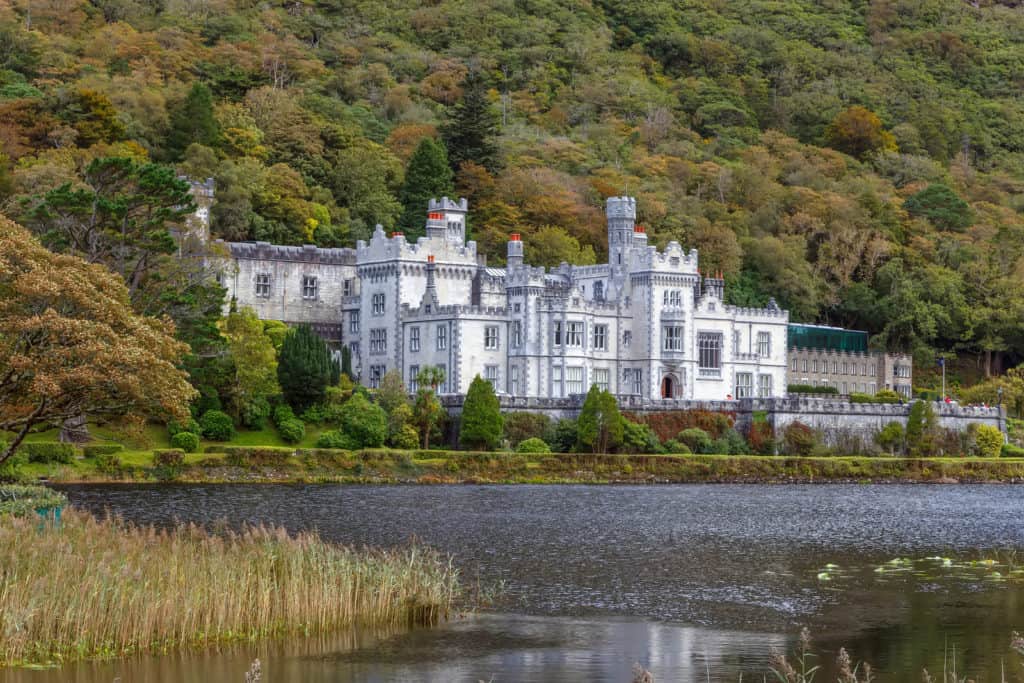
A legendary Irish castle featured in this article is Kylemore Castle (also known as Kylemore Abbey), founded in 1920 on the grounds of the Benedictine Monastery in Galway County, Connemara. The castle was initially designed as a private residence for the family of Henry Mitchell, a wealthy London doctor and liberal politician. The abbey was founded for Benedictine Nuns who escaped from Belgium during WWI.
Located only an hour away from Galway, Henry poured his life’s energy into creating an estate that would showcase what could be achieved in the remote wilds of Connemara. Today, Kylemore Abbey is owned and run by the Benedictine community.
The construction of this residence began in 1867 with a hundred men and four years to complete the work, which cost a little over £29,000. The castle occupies approximately 40.000 square feet and consists of over seventy rooms. Inside is a large ballroom, a billiard room, a library, a study, a gun room, 33 bedrooms and much more.
After Henry Mitchell and his family returned to England, the castle was sold to the Duke and Duchess of Manchester in 1909. However, due to heavy gambling debts, they also had to sell the property. In 1920, the Benedictine Nuns bought the land with the Abbey, the castle, and the Victorian gardens.
Unfortunately, its status as one of the legendary Irish castles did not prevent it from getting heavily bombed during WWI. It was rebuilt only thanks to the Benedictine community and the donations of private citizens.
The nuns took possession of Kylemore Castle and estate in 1920 for £45,000. In The History of Kylemore Castle and Abbey by Kathleen Villers-Tuthill, Mother Abbess Magdalena Fitzgibbon recounts the rich history of the legendary castle, “Kylemore Abbey has been a Benedictine House for over eighty years. The Abbey, which was once a fairy-tale Castle, was built in the 19th Century by Mitchell Henry and stands today as a monument to a great gentleman and kindly landlord who spent most of his fortune on the estate and for the good of the local people…Founded in Ypres in 1662, our community was made an Irish House in 1684.
At the request of King James 11, and under the guidance of Lady Abbess Butler, the Community moved to Ireland in 1688. However, following James’s defeat at the Battle of the Boyne two years later, the Nuns returned to Ypres, remaining for the next 224 years. Since its beginning, Kylemore has been a focal point in the West of Ireland. Previous generations of Benedictine Nuns, for whom Kylemore served as home, have left us with a legacy of love for the place, a sense of stewardship for its continuance and a recognition of its uniqueness in location and attraction.”
“Kylemore is an oasis of peace in a restless world, and we, as a community, are glad to share this peace with all who visit. The Benedictine life is balanced with prayer and work (Ora et Labora), and at the Abbey, we invite those who wish to do so to join us in worship.
“Mitchell Henry was a deeply spiritual person, and it can only please him to know that a Community of Benedictine now has its home in his Castle, praying for the Liturgical Hours while maintaining the estate and undertaking the tremendous task of observing and restoring its many natural and important heritage features”.
Kylemore’s history is not free from tragedy, as an enormous fire took hold of the Abbey in 1959. Lady Abbess Agnes, the youngest Abbess in Europe at 36, recalled the terrifying events of that fateful night, “I remember waking up about two in the morning, and I heard a cracking sound…I ran to the school dormitory, called the nun sleeping there and told her to get the girls up. We got them out the back way, and a door led onto the mountain at the back. We would all have been burnt if that door had not been there. We had just left in time when the dormitory was up in flames.”
Now comes the part about the legend. It is said that a beautiful white horse rises from the water in front of the Abbey once every seven years. In 2011, several Kylemore Abbey staff members claimed to have seen a white horse on the lake’s surface on a particularly windy day. The strong wind raised only white foam, but the “apparition” only fueled the legend. Kylemore is, therefore, often referred to as “Pol a Capall”, which translates as ‘The Place of the Horse’.
Blarney Castle (Kiss the Blarney Stone!)
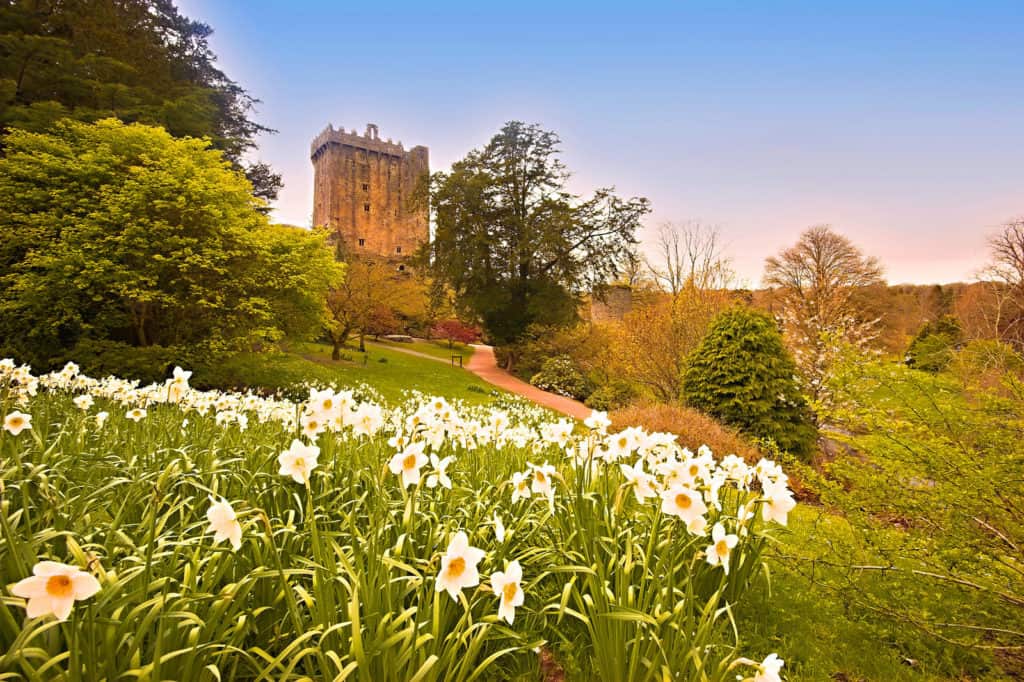
Everyone must have heard the popular idiom once or twice, but have you ever wondered where it originated? This is perhaps one of the most well-known Irish urban legends.
The medieval fortress in Country Cork is perhaps one of the most famous castles, spawning a legend that has lasted for hundreds of years.
Although it was initially constructed in the 13th Century, nothing much remains of the original fort, which was destroyed in 1446. It was rebuilt again by Cormac Laidir MacCarthy, Lord of Muscry.
Throughout history, Blarney Castle has often changed owners until it got to the Jefferyes family. The descendants of the Colthurst family, a relative to the Jefferyes through marriage, still live at Blarney House.
As for the legend tied to the fort for so long, it is said that if you kiss the Blarney stone at the castle’s peak upside down, you will receive the gift of eloquence. The legend was perpetuated by many world leaders and public figures who have taken it upon themselves to take the almost impossible risk, including Winston Churchill, Mick Jagger, Laurel and Hardy,
Thankfully, the once tricky endeavour is slightly more safeguarded as the parapet is fitted with wrought-iron guide rails and protective crossbars. However, the climb is still not recommended for the faint of heart or those with extreme fear of heights.
The tradition originated in the 18th Century, although another legend may suggest that it was in circulation over a hundred years earlier than indicated. It is said that when Queen Elizabeth I deprived Cormac Teige McCarthy, the Lord of Blarney, of his traditional land rights, Cormac, who was desperate to persuade the Queen to change her mind, met an old woman on the way who told him that anyone who kissed a particular stone in Blarney Castle would be given the gift of eloquent speech, “Cormac when Blarney Castle was built, one stone was put into place by a man who predicted no one would ever be able to touch it again.
If you can kiss that stone, the gift of eloquence will be conferred upon you.” Cormac, who was not known as an eloquent speaker before that incident, went on to persuade the queen that he should not be deprived of his land. The word “blarney” means skilful flattery or nonsense. It supposedly came into use after the incident with Queen Elizabeth.
The legend of the Blarney Stone is shared far and wide, with many believing it has supernatural powers. Here’s a snippet from the Washington Post on the powers bestowed upon Winston Churchill, one of the many who have braved the dangerous climb for the sake of the precious gift.
“Mr Churchill is a dangerous public man,
according to all the traditions,
for the learned lexicographers’ state
that he who kisses the Blarney Stone
is endowed with the power ‘to blarney,’
and ‘to blarney,’ they say, is to humbug
with wheedling talk so as to gain a desired end….”
Washington Post, 28 July 1912
There are plenty of legends surrounding the stone’s origins. One legend claims the Blarney Stone was Jacob’s Pillow. Jeremiah is said to have brought it to Ireland, where it became the “Lia Fáil,” meaning Stone of Destiny. This was the stone on the inauguration mound on the Hill of Tara, where the High Kings of Ireland were crowned.
Another myth claims the stone was St. Columba’s deathbed pillow. He died on the island of Iona, and after his death, the stone was moved to mainland Scotland, where it became the Scottish Stone of Destiny.
The stone returned to Ireland as a gift from Robert the Bruce to Cormac MacCarthy, King of Munster and owner of Blarney Castle. Cormac sent five thousand men to Scotland to help Robert the Bruce defeat the English at Bannockburn in 1314.
Another widely circulated legend claims that the stone was brought back to Ireland from the Crusades. This myth claims it is the “Stone of Ezel,” the biblical stone David hid behind to escape Saul.
Nonetheless, most of these legends have now been discredited as, according to the Guardian, Geologists at the University of Glasgow’s Hunterian Museum have now revealed the true origin of the Stone after studying a historic microscope slide; they discovered that the Blarney is a limestone that is geologically unique to the region where it is based.
Classiebawn Castle
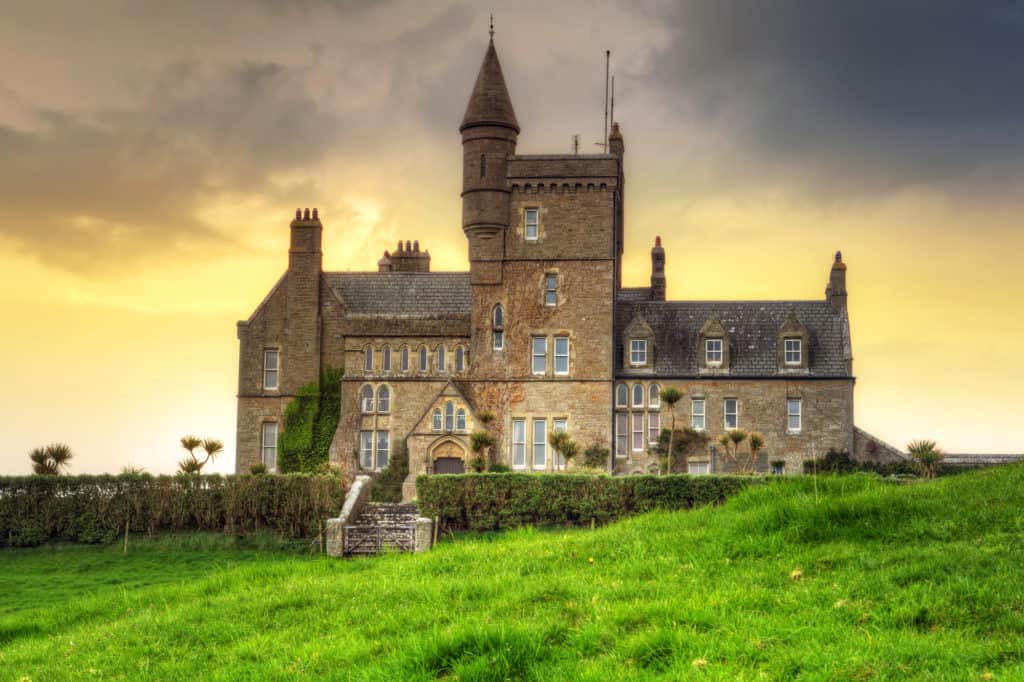
Many legendary castles worldwide have their own resident ghost stories, most of which result from the tragic death of the person whose ghost now haunts the location. The same applies to Classiebawn Castle.
Viscount Palmerston built the Victorian mansion on an estate of about 10,000 acres on the Mullaghmore Peninsula in County Sligo. The castle was later expanded in the 19th Century.
Like many other Irish castles, the castle has changed owners over the centuries. One of these owners, Edwina Mountbatten, Countess of Mount Batten of Burma, and her husband provided the building with electricity and the main water supply. It was Lord Mountbatten’s tragic death that spawned the haunting stories surrounding the castle, as his ship was blown up by the IRA in 1979. Legend has it that his ghost is still roaming the halls of the castle, unable to find peace as a result of his violent and sudden death.
It is also interesting to note that Lord Mountbatten was practically royalty. The deceased nobleman was Queen Victoria’s grandson, the Prince of Wales’s great uncle, the last Viceroy of India, and the former Supreme Allied Commander during WWII. Queen Elizabeth alluded to the tragic incident during a royal visit to Ireland in 2011, saying that the Troubles had “touched” the Royal family personally.
Kilkenny Castle
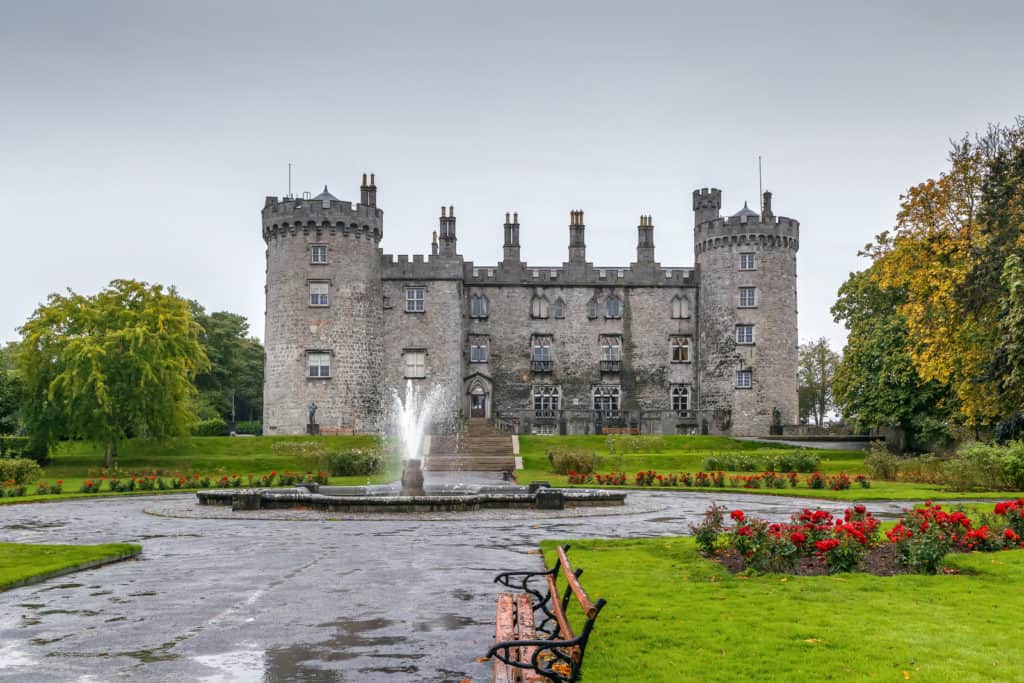
Dubbed as one of the most haunted castles in Ireland, Kilkenny Castle belongs on our list. Built in 1195 to control main roads and the Nore River, several tragic events have occurred at the castle throughout its history. When the flood of 1763 caused John’s Bridge to collapse, 16 people lost their lives, and until now, many of the castle’s visitors insist that they have seen their ghosts trying to escape towards the castle. These ghost stories are further perpetuated by the castle’s managers and even the locals themselves, who insist that Kilkenny somehow holds the souls of all the people who died on its premises.
In 2010, two teenagers claimed they witnessed one of these paranormal activities. While visiting the castle with their mother, they took a photo inside the castle and later noticed a strange white light that seemed unexplainable in the dark interior of the castle.
Adding even more spookiness to the castle is another regular occurrence shrouded in mystery. During the night, while the Parade Tower is locked to outside visitors, an electronic counter placed at the tower continues to count up to a hundred visitors. It is worth mentioning that the building formerly served as a dungeon where many have been imprisoned before passing away. Now, the starting point for the castle tour.
Another famous historical incident at the castle, particularly at the tower’s site, was the Dame Alice Kyteler witch trial, which is said to be the world’s earliest recorded witch trial.
After marrying for the fourth time, suspicions were raised concerning the sudden and untimely deaths of Dame Alice’s previous three husbands. The accusations against her were further fueled by the testimonies from her children and fourth husband’s children, who also accused her of attempting to poison their father. Her trial took place at Kilkenny Castle in 1324. While her servant Petronella confessed to sorcery and witchcraft after being tortured and burned at the stake, it is said that Dame Alice fled to the UK, and no record has existed of her ever since.
Dame Alice’s house is now open for visitors, some of whom insisted they have seen her ghost roaming about on occasion.
Another alleged ghost said to reside at Kilkenny Castle is Lady Margaret Butler, who was married to Sir William Boleyn and was the paternal grandmother of Anne Boleyn, the second wife of King Henry VIII of England. Since she was born at the castle, it is said that her spirit returned to her place of birth upon her death.
Shankill Castle
Initially a Butler tower house, Shankill Castle was rebuilt in 1708 as a Queen Anne house. The castle and surrounding gardens are open to visitors, and grounds tours are regularly provided. Elizabeth and Geoffrey Cope purchased the castle in 1991, and their daughter Sybil has recounted her experience with paranormal activities while she lived there.
The Aylward family built Shankill Castle in the early 18th Century, and their vault lies in the graveyard on the grounds. “In the 1700s, Peter Aylward’s body was placed in the vault, but his remains were stolen and never found. The legend goes that he was never properly laid to rest, and his ghost now roams the upstairs corridor because it is never at peace”, Sybil explains.
Another well-known incident occurred in the 1990s when a Vogue photographer worked on a photo shoot at the castle, particularly in the Blue Room. However, he could not stay in the room long, explaining that “he didn’t go into the room as he didn’t want to disturb the old lady in the rocking chair. My mother was stunned because there was no older woman. He was convinced it was real and described the woman who fit my grandmother’s description. She had passed away only a few months previously and had slept in the room.”
Huntington Castle
Built in 1625, Huntington Castle is known to have survived a tumultuous past full of invasions and rebellions. The castle has its own repertoire of paranormal activity and ghost stories. One particularly gruesome event has left its mark to this day after nine local rebels were captured by the North Cork militia in 1798 and hanged from the castle’s avenue trees.
The castle was built on the site of a 12th-century abbey, so it said that sightings of monks have been reported on the grounds. There have also been sightings of soldiers in the attic, and the Bishop of Limerick’s ghost is said to haunt one of the castle’s main rooms.
The castle’s gardens are also not safe from roaming spirits. The ghost of Ailish O’Flaherty, the first wife of Lord Esmonde (who established the castle), is sometimes seen combing her long hair and wailing as she mourns her husband and son, who went off to the wars and awaits their return.
Another tragic figure seems to haunt the castle; this time, a soldier has been heard knocking on the castle door. As the legend goes, the Cromwellian soldier lived in the 17th Century and had been sent to spy on the enemy, so he disguised himself in their clothes, but sadly, upon his return, his comrades failed to recognise him and shot him dead on sight.
Leap Castle
Murder, bloodshed, and conspiracies are usually the main elements of medieval history. It would make for an exciting tour of the grounds in this day and age. There are different accounts of when Leap Castle was constructed, which adds to its air of mystery, but it is said that it was most likely built in 1250 by the O’Bannon clan. By the 16th Century, the O’Carroll Clan had gained possession of the castle, but a history of strife within the family followed it. A rivalry between the O’Carroll brothers resulted in the murder of one of them at the hands of the other in what is now dubbed the “Bloody Chapel”.
The Bloody Chapel also supposedly contains a tiny chamber entered through a narrow door, designed initially as a safe room for valuables. However, the O’Carrolls reportedly used the chamber as a dungeon where prisoners were tossed into the room to die, and their bodies were left to rot. The morbid practice was discovered in the late 19th Century when cartloads of bones were found in the area.
Leap Castle gained notoriety after it was purchased by Jonathan Charles Darby, whose wife, Mildred Darby, wrote Gothic novels and held séances there.
Loftus Hall
Built in the 14th Century, Loftus Hall is said to be one of the most popular haunted houses in Ireland. Perhaps this is due to a long-standing rumour that the house is haunted by the devil himself and the ghost of the young girl who was said to have seen him.
The story goes that the Tottenhams came to take care of the mansion in 1666 while the Loftus family was away on business. Anne, Charles Tottenham’s young daughter from his first marriage, accompanied them.
When the family welcomes an unexpected guest who arrives on a ship docked not far from their mansion, Anne notices that the mysterious man has a cloven foot. It is said that the man suddenly escaped through the roof, leaving behind a large hole shaped like him.
Unfortunately, the ordeal left young Anne traumatised, and it is said that the family kept her locked away in her favourite room. In other accounts, it is said that Anne was the one who chose to isolate herself. She remained in that room until she died in 1675.
Nevertheless, the story does not stop there. It is believed that the hole the mysterious guest left behind could never be adequately repaired, and the ghost of a young woman, presumed to be Anne Tottenham, and tourists even reported catching glimpses of her in 2011 when the house was opened for visitors.
Charles Fort
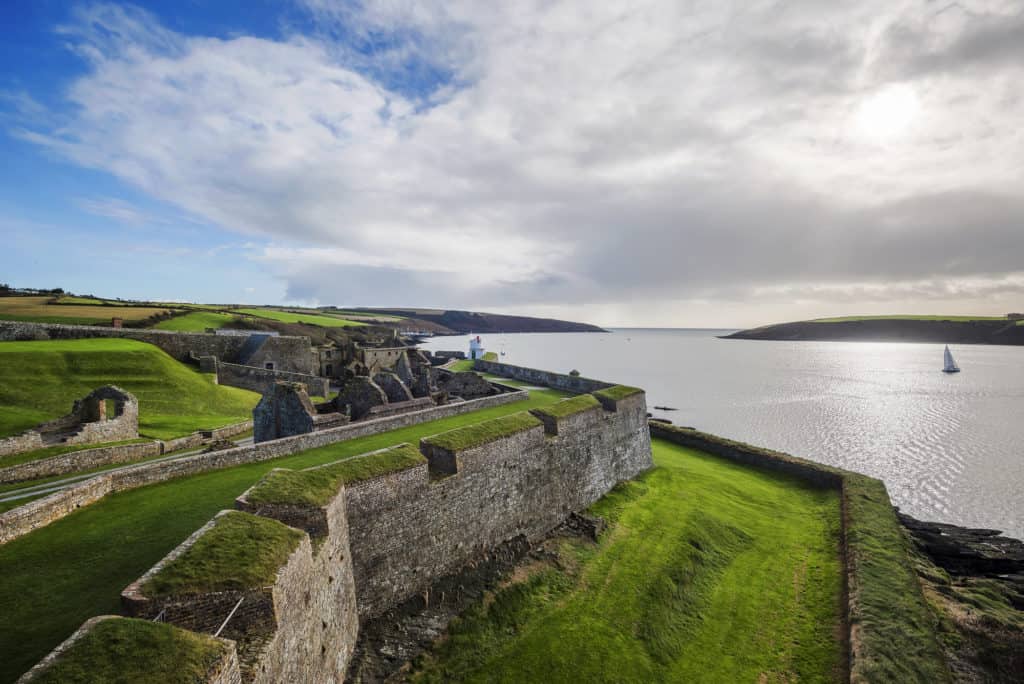
The urban legend based in Charles Fort, Cork, has a bit of a Romeo and Juliet twist. According to the legend, the legendary castles of Charles Fort are haunted by the ghost of The White Lady, a woman who is said to have killed herself after her husband was murdered on their wedding night by her father, who also committed suicide after the shock of losing his daughter.
Many, mostly children, have reported sightings of the ghost, who they say is quite friendly.
Another legend account states that the bride was a local girl who married one of the foot soldiers at the Fort, and they were supposed to spend their wedding night there. However, when the soldier got drunk from the day’s celebrations, he fell asleep during his watch duty, which prompted the other soldiers to shoot him at his post, as per protocol back in the day. After hearing about her husband’s sudden death, his bride flung herself to her death from one of the Fort’s walls.
Dunluce Castle
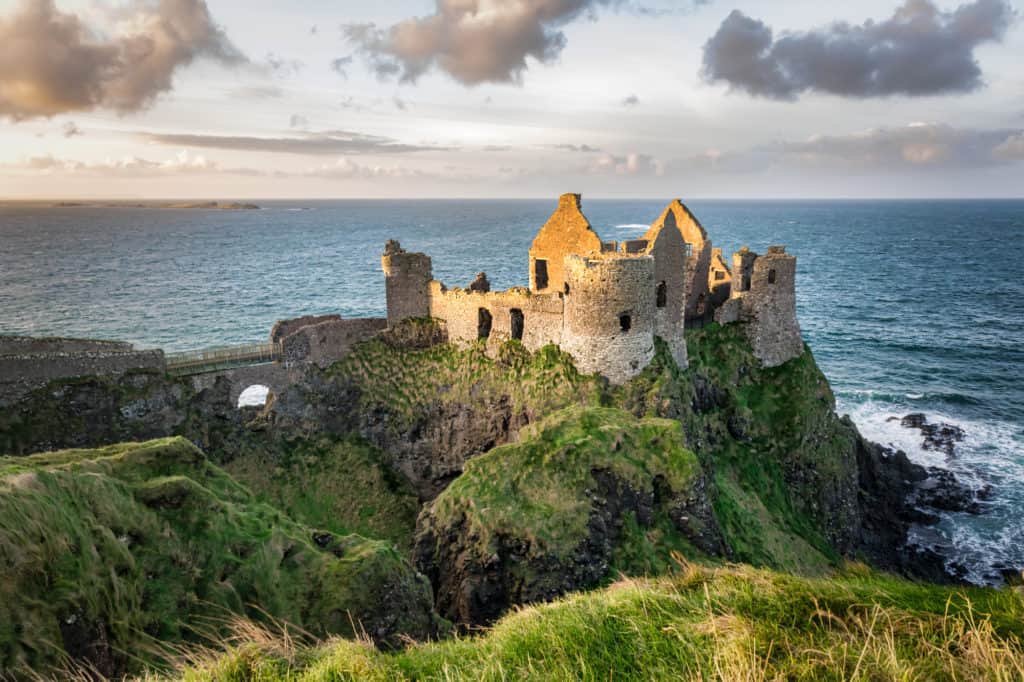
The name ‘Dunluce’ translates into ‘fort of the fort’; however, no one knows the meaning of the earlier name ‘Dunliphis’. Dunluce Castle is a medieval Irish castle in Northern Ireland’s County Antrim. This Irish castle is surrounded by steep drops on each side, drawing the early Christians and Vikings to where an early Irish fort once stood. The castle is under the care of the Northern Ireland Environment Agency.
In the 13th Century, Richard Óg de Burgh, the 2nd Earl of Ulster, built the first castle at Dunluce. Historical resources first document the castle in 1513in the hands of the McQuillan family. The McQuillans were the Lords of Route from the 13th Century until they lost two major battles against the MacDonnells during the 16th Century.
Situated one hundred feet above the ocean, Dunluce Castle was the seat of the chief of Clan MacDonnell of Antrim and Clan MacDonald of Dunnyveg. In 1584, the Sorley Boy MacDonnell seized the Antrim Glens, swearing allegiance to Queen Elizabeth I. Subsequently, his son Randal was made 1st Earl of Antrim by King James I.
Four years later, a ship from the Spanish Armada, dubbed the Girona, was shipwrecked on the rocks nearby. The boat was taken apart as the cannons were installed in the gatehouses, the rest of the cargo was sold, and the funds were used to restore and expand the castle.
Although the castle dates back to the 13th Century, a souterrain dating back 1,500 years has been discovered.
This historic castle has been the site of numerous battles. Over a one-hundred-year period, it was besieged multiple times. It is also the location of many legends. A local legend states that at one point, part of the kitchen next to the cliff face collapsed into the sea.
According to a widely known legend, when the kitchen collapsed, only a kitchen boy survived the crash, as he was sitting in the only corner of the kitchen that did not collapse. However, the kitchen is still intact and next to the manor house. You can still see the oven, fireplace, and entryways. It wasn’t until sometime in the 18th Century that the north wall of this Irish castle building collapsed into the sea.
Another story revolves around Maeve Roe, whom her father locked away in the castle’s northwestern tower for refusing to marry her suitor. However, she managed to escape with her true love and fled to Mermaids Cave, where they fled by boat but were dashed against the cliffs. Maeve’s ghost is still said to sweep her prison tower.
Another legend involves the MacDonnells, who, after their expulsion, besieged the castle more than once until their forces climbed into the corner towers and hanged the English captain. His ghost is said to haunt a tower.
Dunluce Castle was the seat of the Earl of Antrim until 1690 when it fell into ruin.
In 2011, archaeological excavations in the area discovered the remains of the town of Dunluce, which was destroyed during the Irish uprising of 1641.
The town was built in 1608 by Randall MacDonnell, the first Earl of Antrim. It may have contained the innovative housing in Europe during the early 17th Century, which included indoor toilets, which had barely been introduced in the rest of Europe at the time, and a complex street network based on a grid system.
Visitors can explore the cobbled streets and a Scottish merchant’s house, a blacksmith’s forge, a courthouse, and a dungeon. Plenty of evidence of wealth and luxury, including coins from the period of Elizabeth I and Charles I, is also on display.
One of the iconic historical figures linked to the castle is Winston Churchill, who once owned the estate and passed it on to his family.
The castle has inspired many literary works, including the orchestral tone poem Dunluce (1921) by Irish composer Norman Hay. It is also thought to be the inspiration behind Cair Paravel in C. S. Lewis’s Chronicles of Narnia (1950–1954). This Irish castle is also the subject of a 1990s song named “Dunluce Castle,” written by George Millar and sung by the Irish Rovers.
The Dunluce Castle has also been featured in the HBO hit drama series Game of Thrones, serving as the stronghold of Pyke on the Iron Islands.
Belfast Castle
Belfast Castle is situated on the sweeping slopes of Cavehill Country Park in Belfast, the capital city of Northern Ireland. It is four hundred feet above sea level and provides a magnificent view of the city and Belfast Lough.
The original Belfast Castle was built in the 12th Century by the Normans in the town of Belfast itself in what is now Belfast city centre. The castle was home to the 1st Baron Chichester (Sir Arthur Chichester), but unfortunately, it was burned down in 1708. The Chichesters decided to forgo the original site and rebuild their new residence in the suburbs, where today’s Belfast Castle is.
The new castle was built from 1811 to 1870 by the 3rd Marquess of Donegall and was designed in the Scottish baronial style by Charles Lanyon and his son. After Donegall’s death and the family’s financial demise, The 8th Earl of Shaftesbury oversaw the completion of the construction process.
The 9th Earl of Shaftesbury presented the castle to the City of Belfast in 1934. The Belfast City Council began a major refurbishment over ten years, starting in 1978, at a cost of over 2 million pounds. The building officially re-opened to the public on 11 November 1988.
This Irish castle boasts an antique shop, a restaurant, and a visitor’s centre. It is a popular venue for conferences, private dining, and wedding receptions.
The Shaftesbury family was a generous donor to Belfast, supporting many charities and hosting garden parties on the castle grounds. The 9th Earl of Shaftesbury became Lord Mayor of Belfast in 1907 and Chancellor of Queen’s University in 1908.
The castle belonged to the family until they presented the estate to the City of Belfast in 1934. After the Second World War and until the 1970s, Belfast Castle was a popular venue for wedding receptions, dances and afternoon tea parties.
In 1978, the castle closed as part of a refurbishment process that cost an estimated £2 million and was overseen by Hewitt and Haslam Partnership architects. It reopened in 1988 and now hosts weddings, conferences, and other events.
Belfast Castle is one of the most striking buildings in Belfast, and it welcomes hundreds of visitors who usually enjoy afternoon tea in the Castle Tavern or stroll around the gardens.
The Donegall coat-of-arms is situated right above the front door of Belfast Castle. A section of the Shaftesbury crest is also located on the exterior staircase, which has become a popular wedding photography spot. The castle boasts a six-story square tower; the entrance faces the steep slope of the hillside and has a porch with decorative Doric columns.
In 1894, the principal rooms were connected to the terrace below by an Italian-style serpentine outside staircase, a gift from the 9th Earl of Shaftesbury to his mother.
The castle’s estate is now part of the Cave Hill Country Park. The park has three trails, one rising the hill past the caves to McArt’s Fort.
The park is named after the five caves on the cliffs’ side. It contains numerous archaeological and historical features, including Napoleon’s Nose, which is believed to have inspired Jonathan Swift’s novel Gulliver’s Travels. The Park is also home to McArts Fort, an ancient fort standing 1,200 feet above sea level.
Ballyloughan Castle
A great example of these Irish Castles is also Ballyloughan Castle in County Carlow. An Anglo-Norman lord built the ruined castle in the 14th Century. Towards the end of the 16th Century, the Irish Kavanagh family occupied the castle. Following the defeat of the Confederation forces in 1641, the castle and lands were forfeited to the crown. The estate then passed to the Beauchamp family, who built a large residence nearby in the 17th Century. Afterwards, it passed to the Bagenals and the Bruens in the 19th Century.
It consisted of a large open courtyard with a curtain wall and a moat outside. The only things that remain of the castle are a small square tower and the entrance gate flanked by two towers. It is also noteworthy that beyond the grounds of the castle stands a 17th-century ruined house.
Unfortunately, visitors cannot access the castle but can view it from the nearby adjacent gate.
Visitors can also find nearby attractions such as the Southern County Resort, which has three stunning lakes stocked with various types of marine life. Fishing is allowed on those lakes, or you can spend some time at the Lake Café for a soothing warm drink or a selection of delicious desserts and milkshakes.
If you’re interested in sporting activities, there is also a large beach volleyball court on site. If you’ve got children with you, they can spend their time at a small playground near The Lake Café, which has sand pits and swings. Families can throw their picnics at the BBQ areas or take some photos to always keep these beautiful memories with them. The resort is open all year round, seven days a week, from 9:00 a.m. to 7:00 p.m.
If you’re more interested in arts and crafts, you can visit the Woodturning Study Centre, owned by Glenn Lucas, a skilled Irish craftsman and experienced teacher. His classic bowls, made from Irish native wood, are available.
Ballymoon Castle
Ballymoon Castle is two miles east of Muine Bheag, in an open meadow just east of Bagenalstown and County Carlow, Ireland. It was believed to have been built between 1290 and 1310 in the 13th Century.
Like the previously mentioned castle, Ballymoon Castle is a ruin with a square courtyard and high granite walls. The inside of this Irish castle is open, and there are no traces of the interior structure apart from the foundations, which led historians to believe that the castle’s construction never reached completion as it was started during a chaotic period in Irish history. After the Norman invasion of the 12th Century, the Normans dominated most of Ireland, including the area surrounding Ballymoon.
Some also believe it was built by the Bigod family, Earls of Norfolk, or the Carew family, who bought the land from them. In the 19th Century, Michael Sheill from Wexford purchased the castle and established several local businesses there.
Ballymoon Castle was given to the Bigod family when the last Lord of Leimnster, Anselm Marshall, died in 1245 without an heir since the castle was part of the Lordship of Leinster. The colony suffered severe social, environmental, and economic crises in the late 13th and early 14th centuries. Warfare broke out between two factions within the colony, the de Burghs and Fitzgeralds, causing widespread destruction.
Afterwards, Gaelic Irish families began to regain their power and reconquer lost territories from the Normans.
Ballymoon experienced similar events in the 14th Century when the O’Byrnes attacked it. The chaos that engulfed the area was reflected in the castle’s construction.
Visitors can cross a small wooden bridge over a ditch to reach the castle, which is considered a National Monument. To access the castle’s interior, you can breach the wall or enter the large gatehouse. Once inside, you’ll find several worn steps leading to a dark chamber. You can also climb to the top of a southeastern wall to take in the view and imagine what it must have been like to be a sentry guard at the time.
Like many other Irish castles, Ballymoon has its own ghost story. As told by school girls from the Newton, Dunleckny School, “There was a farmer named Mr Wilkinson Bohermore, Bagnastown. In a townland called Dunkeckney near Mr Wilkinson’s house, an older man with two goats lived at once. Near this place, there is a very ancient graveyard.
This man used to go to the graveyard to collect ivy from the trees to feed the goats. One night, it was rather late when he went into the cemetery to collect the ivy, and he heard some terrible screams. At this, the man became terrified, lost his way, and wandered far from the graveyard.
At last, he found himself beside an old ruin, which he afterwards recognized as Ballymoon castle. He entered the old ruins, sat down, and soon fell asleep. He awakened quickly and noticed a small red light shimmering through the gloomy old ruins. Looking around, he saw a lady standing at one of the old ruins’ doors, with her finger outstretched, as if she desired him to leave the ruins. Taking it as such, as soon as he could, he ran out.
But try as he might, he did not escape the old castle and kept running around in a circle. At last, he fell, worn out by the fatigue. A friend picked him up the following day. This story was believed at first, but certain people who mocked the story went to watch the castle. Whatever they say, they get a ghost fright but refuse to tell anything about it. The story of the appearance of this unearthly woman has now become a legend, and local people talk of it as the Ghost of Ballymoon Castle.”
We’re intrigued by this story and wish we knew if it’s true. Have you ever heard of it before?
Carlow Castle
Built between 1207 and 1213, Carlow Castle is located on the eastern bank of the River Barrow in County Carlow, Ireland. Although the name of Castle Carlow’s builder is widely disputed, it is assumed that it was Norman invader Hugh de Lacy circa 1181.
Another theory is that upon the death of Richard de Clare, 2nd Earl of Pembroke, his daughter and only heir, Isabel, married William Marshal; he built the castle after inheriting the title of Earl of Pembroke through his marriage.
Marshal was an Anglo-Norman soldier and statesman who served five English kings: Henry II, the “Young King” Henry, Richard I, King John, and Henry III.
He was knighted in 1166 and was known as a successful tournament competitor. Stephen Langton even eulogized him as the “best knight that ever lived.” He became the Earl of Pembroke in 1189, and in 1216, he was appointed a protector for the young King Henry III, who was nine years old at the time and regent of the kingdom.
Marshall wanted to build a market town to initiate trade relations with other towns along the river Barrow.
William Marshal’s legacy has remained strong through the ages, so much so that many famous fiction works, including Heath Ledger’s character in A Knight’s Tale, were based on him.
Writer and historian Victor Hadden once said, “The Castle of William Marshal here in Carlow is probably unique, not for its size, or its strength, or its date, or its architecture but for the wonderful records and accounts which are still extant and which show beyond all doubt the highly evolved system of administration and accountancy which enabled the Normans to control the agriculture and economic welfare of most of Leinster, from their Castle in Carlow”.
The castle’s design was a first of its kind in Ireland. It was a towered keep, with a tall rectangular tower surrounded by four smaller towers.
The castle has quite a turbulent history. It was handed over to the crown in 1306 and granted to Thomas Plantagenet in 1312. The crown confiscated it again in 1537 due to its lack of landlords, and was bought by the Earl of Thomond in 1616. Finally, it was taken by Oliver Cromwell in 1650 but later returned to the Earl of Thomond.
Although Carlow was once a solid military fortress, situated strategically to withstand repeated attacks, which it certainly did, from 1494 to 1641, by Irish Clans, the Kavanaghs, O’Tooles, O’Byrnes, O’Lalors and O’Moores, in 1494, the castle was taken over by James Fitzgerald of Kildare. Over the next Century and a half, the castle continued to face repeated attacks by Silken Thomas (1524), Rory Oge O’Moore (1577), Sir Morgan Kavanagh (1641), Thomas Preston (1646) and Oliver Cromwell in 1650.
In the 19th Century, specifically in 1814, the castle was destroyed with explosives to build a lunatic asylum. Dr Philip Parry Price Middleton spent two thousand pounds on the overall renovations. However, the efforts exerted to do so ended in destruction.
To create an underground passage using dynamite, the explosives were placed underneath the eastern castle wall, which led to its collapse along with the east towers and adjoining walls.
The only remaining structures from the original castle are the west wall and the two towers closer to it.
A team of archaeologists excavated Carlow Castle in 1996. Its remains now overlook the town of Carlow, founded in the early thirteenth Century.
The team of archaeologists were led by Dr Kieran O’Conor, who noted that Carlow Castle “is one of the most important in the evolution of castles in either Ireland, England or France, there is nothing to match the architectural style of Carlow Castle to be found anywhere until at least 20 years after its completion”.
Carlow Town is full of interesting monuments and landmarks, so if you are ever in the area, make sure to visit the following locations.
The Carlow Courthouse is located at the end of Dublin Street. It is considered to be one of the finest courthouses in the country. It was designed by William Vitruvius Morrison in 1830 and completed in 1834. Its design resembles that of a temple on a high podium.
You can also visit St. Patrick’s College, which opened in 1793 as a large country house, or Carlow Cathedral (1833), with its gothic design envisioned by Thomas Cobden.
Suppose you stop by the Liberty Tree in Carlow, commemorating the 1798 Rising of the United Irishmen. In that case, you’ll be able to admire its design, created by John Behan, where people gather to relax in the summer months.
Another notable landmark in the area is St. Mary’s Church, which dates back to 1727, and Graiguecullen Bridge, one of the oldest bridges on the River Barrow, built in 1569.
A well-known monument is the Croppies Grave, where the bodies of 640 Carlow insurgents were buried in a mass grave after the rise of the United Irishmen in 1798.
Carlow Town Hall, designed by William Hague in 1884, lies on the north side of the Haymarket is the Town Hall.
You can also find ancient landmarks in the area, such as the Brownshill Dolmen, a megalithic tomb dating back 4,900 to 5,500 years ago. According to Irish folklore, dolmens were the tables or graves of giants, druids’ altars, or entrances to the Underworld of the Tuatha De Danann.
Several museums are located around Carlow, such as the Carlow County Museum and the Carlow County Military Museum, which lies within a 19th-century church and features many exhibits relating to Carlow’s military history.
Huntington Castle is a castle in Clonegal, County Carlow, Ireland. They are also known as Clonegal Castle Huntington Castle, built by Sir Laurence Esmonde in 1625.
Sir Laurence served as a soldier for Elizabeth I, rising in the ranks until he became major-general of King James I’s army in Ireland and governor of Duncannon Fort.
He was rewarded for his loyal service with a peerage, becoming Lord Esmonde. His name is not without scandal, or so it was thought of at the time since he caused quite a stir by marrying Ailish O’Flaherty, a devout Catholic and granddaughter of the Pirate Queen Gráinne Mhaol.
The castle was initially built in the Jacobean style as a plantation castle and used for defence during the early 17th Century. The castle’s original tower house was built in the 15th Century as a fort for the Caviness family. The village of Clonegal had strategic importance during the Cromwellian conquest of Ireland because of its location on the road between Dublin and Wexford. Therefore, the castle was taken over by Oliver Cromwell in 1650 as he marched on Kilkenny.
The Esmonde family laid out most of the gardens in the 17th Century, including the fish ponds on either side of the centre walk, the yew trees, and a lake built for ornamental purposes. The River Derry flows along the bottom of the wilderness as well, making for a stunning walk in the gardens.
Now, like most old Irish castles, this one also comes with its myths and legends:
The castle was built on the site of an abbey in the 13th century, which may explain some of the stories about ghosts occupying the castle since then.
“Monks from centuries ago are said to walk up and down beneath the yews…A soldier who was said to have knocked on the castle door is thought to have lived in the 17th Century. He disguised himself in the enemy’s uniform to mingle among them to gather information. When he returned to the castle, his comrades didn’t recognise him as one of their own (being in the other uniform), and they shot him dead at the door…that he now knocks on.
The first wife of Lord Esmonde is said to be seen out in the garden, combing her hair and wailing in anguish, but there are two different stories as to why she is so distraught. One says she is in despair and waiting for her husband and son, who have gone off to war. The other story says she ran off with her infant son, and Lord Esmonde took a new wife, so she is in anguish about that.
The friendly ghost of Bishop Leslie of Limerick, who retired to the castle in the 18th Century, is said to haunt the “Four Poster Room”. Several guests claim to have woken up at night to find him at the foot of the bed.”
Not only that, but since this is Ireland, it is said that the Druids also haunted the palace, creating mischief such as forming mist at will, starting fires, and bringing down showers of blood. The druids were said to have sacrificed people to please the gods, so it is understandable why they are feared. The castle is also famous for its well, which has never run dry over the years.
The Durdin-Robertson family have lived at the 17th-century Huntington Castle for generations.
“Nobody could believe in phenomena if they lived here because we have so much,” says Lawrence Durdin-Robertson. There’s no other thing that explains it; I mean, it’s not a question of light or shadow because the people are there.”
Huntington Castle also has its temple, the Fellowship of Isis temple, which was established in the 1970s as a place of worship for the Egyptian Goddess Isis.
“In the 1640s, Cromwell’s men used this space as a dungeon for their enemies. In 1921, Republicans imprisoned the cook and other members of staff here. In 1976, Lawrence Durdin-Robertson, Baron of Strathloch, a former Church of Ireland clergyman, combined forces with his wife Pamela and sister Olivia to convert the cellars into the earthly headquarters of the Fellowship of Isis. The well-read and sprightly trio sought to provide the world with a spiritual platform that would acknowledge the immense importance of female deities throughout the history of humanity.
At this heart was Isis, the Egyptian goddess, mother of all. The incense-scented Temple of Isis now consists of twenty-six shrines set in a winding pattern throughout the cellars. Within the chapel is a nave, a high altar, and a chapel of Brigid, situated near a Neolithic well known as Brighid’s Well, which is famed for its healing properties. There are also twelve shrines dedicated to the twelve signs of the Zodiac and five small chapels devoted to the elements of earth, air, fire, water and spirit. Huntington certainly has otherworldly solid connections.
Just over a hundred years ago, a meteorite fell to earth and landed near Front Avenue. It glowed for two years, providing a delightfully warm perch for crows who, as any Isis devotees will tell you, are the avian messengers of the Morrigan, one of the principal goddesses of Ireland…The benevolent Fellowship is now a recognized religion in the USA and has a worldwide membership of over 27,000 people…Many gather at Huntington for the four annual festivals, one held every season, involving intensive meditation sessions followed by refreshments in a nearby public house.”
Huntington Castle is now a private house that provides guided tours to the public in June, July, August and September. It was the setting for Stanley Kubrick’s film Barry Lyndon.
Voted as one of Ireland’s top 20 Hidden Gems by The Guardian in 2015, the castle grounds also feature a tearoom and gift shop with delicious cakes and unique gift ideas for adults and children alike.
Guests can also stay at the castle on a B&B basis or at one of the self-catering apartments. With its proximity to several churches, Huntington Castle is also used as a wedding venue.
Leighlinbridge Castle
Leighlinbridge Castle (Black Castle) lies on the River Barrow in Leighlinbridge, County Carlow, Ireland.
The village of Leighlinbridge features narrow streets, grey limestone houses and castle ruins overlooking a 14th-century bridge. At the northern entrance to the town, a sculpture created by Michael Warren has been placed depicting the thrones of the ancient seat of the Kings of South Leinster at Dinn Righ (The hill of the Kings), as it is believed that the Kings of Leinster lived near the village.
The old castle was built for the Normans by John de Clahull (or Claville) in 1181 under the auspices of Hugh de Lacy. Edward Bellingham converted it into a fort in the mid-sixteenth Century. Unfortunately, the remains of the castle, including a 50-foot castle tower and parts of one side of an enclosing wall, are now in ruins.
In the late thirteenth Century, the Carmelites, a Roman Catholic religious order that dates back to the 12th Century on Mount Carmel in the Crusader States, first came to Ireland, founding their first friary in Leighlinbridge near the castle. The Carmelites came to Ireland in 1271, and their first friary was built on the bank of the Barrow River at Leighlinbridge.
Gerald FitzGerald, 5th Earl of Kildare, built the’ White Castle’ nearby around 1408. However, its remains and location were lost forever by 1840.
In 1547, when the castle fell into the hands of Henry VIII’s forces, Lord Deputy Edward Bellingham reinforced the Tower and Bawn and named the imposing building “The Black Castle”. He is also responsible for converting the friary into a fort that served all of Leinster.
Rory Oge O’More of Laois is said to have captured the castle and destroyed part of the town in 1577.
Described as the “Robin Hood” of Ireland, Rory Oge O’More was legendary in the fight against colonial rule during the Elizabethan Period. He was born in 1538 in County Laois as the second son of Rory O’More. His life while growing up was somewhat of a tragic drama penned by Shakespeare himself. His father was killed by his brother in a power struggle within their clan. His uncle soon followed his father during the English rebellion against the new plantation settlers.
The clan’s leadership was passed down to Rory Oge, who was the next in line at 20. Therefore, he became in charge of Laois’s largest and most powerful clan. He sought peace with the English. But it did not last long. He ended up allying with another nearby clan, and his alliances began to grow as more clans joined behind him as he fought the English armies in Ireland.
Although a brief peace was reached, fighting ensued once again, resulting in heavy losses for both sides. As a result, Rory vowed revenge. He went on a rampage, and consequently, a bounty of £1,000 was placed on his head, and he became the most wanted man in the British Isles.
It is said that Rory cost the Crown 200,000 in damages throughout his rebellion. Rory met his end during a raid into the MacGillapatrick territory of Ossory in 1578. The English retrieved his head and placed it on a spike at Dublin Castle. His tragic death made him a martyr in the eyes of the Irish public.
His obituary recorded in the contemporary Annals of Loch Ce and the Annals of the Four Masters says: “Ruaidhri Og O’Mordha was killed by Brian Og MacGillapatraic, and by the Foreigners, and there was not in Erinn, a greater destroyer against Foreigners than that man, and he was a very great loss”. Rory Oge’s son, Owen Mc Rory O’More, continued his father’s legacy in fighting the English.
Throughout these fierce battles, the area saw severe destruction. In the 1590s, the castle underwent several repairs during the O’Neill rebellion.
The rebellion was part of the Nine Years’ War, which pitted the Gaelic Irish chieftains, including Hugh O’Neill of Tír Eoghain, against the English. The war was mainly fought in Ulster and ended in defeat for the Irish lords, the largest conflict fought by England in the Elizabethan era.
During the Irish Rebellion of 1641, the Catholic Confederation initially garrisoned the castle, which, in 1647 and 1649, was used as a rallying point by the Maquis of Ormond. In 1649, Colonel Hewson captured the castle for the forces of Oliver Cromwell.
In the 1840s, what was left of the castle was a four-sided enclosure wall and a round tower in the southwest corner.
Close by is the Leighlin Bridge, on the River Barrow, on the road from Dublin to Waterford. Built in 1320, the Bridge consists of 10 arches and is said to be one of the oldest functioning bridges in Europe.
The castle is easily viewable from the roadside as it stands beside a towpath on the River Barrow. You can also see it quite clearly if you stand directly on the other bank of the river. The collapsed portion of the castle reveals most of the interior.
Tinnahinch Castle
Tinnahinch Castle was built in the old parish of Rearymore in Tinnahinch by Tadhg MacLaighnigh Ui Duinn, who ruled the territory in 1475. The name Tinnahinch comes from the Irish phrase Tigh-na-hlnnse, meaning “House of the Island”, about a previous castle built along the river Barrow further north, which was the principal seat of the Dunne family. A stream flowing into the River Barrow almost surrounded the castle, which created the impression of an island, hence its name. The castle was also located about one mile south of Tinnahinch Bridge.
Hundreds of years ago, the Gaelic name used by the Dunn family in Ireland was Ó Duinn or Ó Doinn, derived from the Gaelic word donn, which translates to “brown”.
Cromwellian forces attacked and blew up the castle under Colonel Hewson in 1653. It was occupied by Charles Dunne, who participated in the Confederate Wars. Charles put up quite a strong defence, resulting in Colonel Hewson using the full force of his artillery to level the castle.
According to Dr O’Donovan, “The present ruins of this castle are very trifling, but it was certainly, when perfect, a castle of considerable importance and extent.”
The Dunnes owned several castles in the Midlands, but most of them were destroyed during the Cromwellian Invasion.
These castles include:
Brittas Castle was built after the destruction of Tinnahinch Castle near Clonaslee, County Laois. It was replaced by a neo-gothic mansion built in the exact location by Major-General Francis Plunkett Dunne in 1869, designed by architect John McCurdy. The house had extensive gardens and a lake. However, it was burned down in a fire in 1942.
Colonel Terence O’Dunne built Ballinakill Castle in 1680 between the River Clodiagh and River Gorragh on the site of an older castle destroyed by Cromwellian invasion forces.
Teige O’Doyne built Coolnamoney Castle near the Glenlahan River. It is now also destroyed.
In 1475, Tadhg MacLaighnigh Ui Duinn built Castlebrack Castle for the Tanist, the clan’s deputy chief. This castle was second in size and importance to Tinnahinch Castle, the principal residence of the Dunnes.
Clarahill Castle was built by younger members of the Dunne family in 1600 and was sadly destroyed in 1900 for road material.
The Dunnes also built Ballinahemmy Castle near Corrigeen, in County Laois, and Raskeen Castle, which Donal O’Dunne constructed in 1584 and destroyed in 1691.
In 1615, Tinnahinch Castle was constructed again by James Butler, the Duke of Ormonde, to control a crossing where a wooden bridge over the Barrow. The castle burned down in 1700.
The Butlers, however, were not known for their excellent standing in society since their name was always linked with scandal.
“Certainly, that phrase coined by Lady Caroline Lamb to describe Lord Byron as “mad, bad and dangerous to know” could apply to the Mountgarret branch of the Butler family of Tinnahinch Castle. He [Butler] seduced the daughter of his host during a hunting expedition, leading her indignant brother to challenge him to a duel.
Butler refused because the brother was not equal. So the stubborn sibling joined the French army and rose to become a decorated officer before returning to Ireland to reissue the challenge, leaving bad-ass Butler no option but to fight the duel. The men were so focused on their bloody brawl that they rolled into the river and drowned.
While there may be no such thing as a free lunch, a fatal feast is surely taking things too far, judging by another brutal Butler. He invited many of the neighbouring chieftains to dinner, waiting until they were all seated and salivating before locking the doors and flooding the castle by means of large cisterns at the top of the building. The chieftains’ heavy clothing thwarted their attempts to draw their swords from their scabbards, so they drowned.
Perhaps there is truth to the tale, for several skeletons were discovered when a turbine race was cut to the south of the castle in the early 1900s. More challenging to prove is the myth that horrified monks in Duiske Abbey reacted by putting a spell on the town, which means it always rains on days when there are significant events, like an assembly, fair or meeting – making you wonder what the rest of us did to deserve our frequent daily downpours.
Another Butler, by the name of Tybott, was so twisted that he was nicknamed ‘Mad Butler’, making it all the more bizarre that a widow approached him for help controlling her spirited son. Butler solved the problem – by hanging her child. The distraught widow threw herself on her knees and prayed that Mad Butler might also meet a violent death. Sure enough, like his abusive ancestor, he died at the hands of an angry brother-in-law, who shot him for ill-treating his sister.”
Bailieborough Castle
Bailieborough Castle (also known as Castle House or Lisgar House) was situated in Bailieborough, County Cavan, Ireland. Built in 1629, the castle is now known as Bailieborough Demesne. Although it has been demolished, a hiking trail called Castle Lake Loop spans 3 kilometres around part of the former castle.
The Irish translation of Bailieborough is Coill a Chollaigh, which means “forest of the boar”.
The lands on which this Irish castle was built were granted to William Bailie, a Scottish “undertaker”, by James I in 1610 to build a house where Scottish or English families could be settled on the estate. During the 1641 rising, a troop of Irish soldiers led by Colonel Hugh O’Reilly attacked and occupied the house for a whole month.
In 1724, the estate was sold to Major Charles Stewart and then to Colonel William Young in 1814. Colonel Young established the town of Bailieborough in its present location and was made 1st Baronet Young of Bailieborough in 1821. In 1918, the house burned down, and although it was partly rebuilt, it was later on sold to the house to the Department of Lands. The house was demolished soon after.
The ruins of the First Parish Church are the oldest building in Bailieborough. Within its burial ground are many of the earliest inhabitants of the town.
The castle grounds are well worth a visit.
Ballyconnell Castle
Ballyconnell, which means “Entrance to the Ford of Conall,” is a town in County Cavan, Ireland. It lies at the foot of Slieve Rushen Mountain and is close to the border between Northern Ireland and Ireland. The town dates back to the 14th Century or even earlier.
Before being named Ballyconnell, the town was named Áth na Mianna, which means Ford of the Miners. It was also named Gwyllymsbrook between 1660 and 1702 by its then-owner Thomas Gwyllym, Bél Átha Conaill in Irish, meaning “The entrance to Conall’s Ford”.
The area itself received settlers as early as 3,500 B.C. The earliest inhabitants were hunter-gatherers who lived by fishing, hunting wild game, and foraging for berries and nuts. They travelled by boat through the river and the numerous lakes and streams.
In 1622, Walter Talbot, the estate’s owner, began building a strong castle. However, a fire destroyed the castle in 1688, and Ballyconnell House was erected in its stead.
By 1652, the area came under the control of Cromwellian captain Thomas Gwyllym. After King Charles II’s restoration to the throne in 1660, James Talbot tried to have the Ballyconnell estate restored to him, but a final grant was made to Thomas Gwyllym in August 1666, and the town was renamed Gwyllymsbrook in his honour.
An extension was added to Ballyconnell Castle in 1687 at a cost of £500, but in 1688, It burned to the ground.
Though recently renovated, the building retains much of its historic character.
Cabra Castle
Cabra Castle is the name given to two castles in County Cavan, Ireland. One is now ruined, while the other is used as a luxury hotel and wedding venue.
The existing Cabra Castle is a mix of the neo-Norman and Gothic styles, built at the beginning of the 19th Century. It was initially called Cormey Castle, after the local townland where it was built. The first owners of the castle were the Foster family. However, they went bankrupt soon after and sold their country house to the Pratt family, followed by the Brennan in 1964, who turned it into a hotel, and then a UAE businessman, who in turn sold it to the Corscadden family, who ran several hotels and still run the luxury hotel until today.
The ruins of the original Cabra Castle lie near the Wishing Well in Dún a’ Rí Forest Park.
This current castle provides spectacular countryside views through its patios and terraces. Cabra Castle has 98 en-suite bedrooms, each decorated in a different style. The castle is less than an hour’s drive from Dublin Airport.
Due to its historical significance, the Cabra Castle Hotel is open to the public between 11:00 am and 4:00 pm year round, except during Christmas vacation.
The hotel is also a lovely venue for weddings and special occasions, and you can also spend your honeymoon in luxury in their excellent authentic medieval-style castle rooms and scenic surroundings.
Saunderson Castle
Castle Saunderson is near Belturbet, County Cavan, Ireland. It was the former family seat of the Saunderson family but, unfortunately, is now in ruins.
Instead, the Castle Saunderson estate has become an International Scouting Centre that opened in 2012 with indoor accommodation and campsites over 34 acres. It currently acts as a World Scouting Centre for the Scouts, alongside the Cairo International Scout Centre in Egypt and others.
The original owners of the estate were the Saunderson family, who acquired the Irish castle during the Ulster plantation. At the time, it was owned by the O’Reillys of Breffni and has been known as Breffni Castle since the 14th Century. Robert Sanderson, who fought with William of Orange, inherited the castle from his father in 1676. However, James II’s troops burned the castle down in 1689.
The present castle dates back to 1840 and was destroyed by fire in 1990.
The property was sold to a businessman in 1977 and turned into a hotel, but the third fire at the castle damaged it.
Cavan County Council created the new Castle Trail at Castle Saunderson in March 2017.
Cloughoughter Castle
Cloughoughter Castle is a ruined castle on a small island in Lough Oughter, County Cavan, Ireland.
The Irish castle is located in the historic Kingdom of Breifne. In the late 12th Century, it was held by the O’Rourkes but later fell into the hands of the Anglo-Norman William Gorm de Lacy.
It is unknown when precisely the castle was constructed, but it is estimated to be sometime in the early 13th Century. In 1233, the O’Reillys took possession of and completed the castle.
The castle continued to move from one owner to another over the years.
Due to the turbulent times and frequent battles in the area, the castle was left in ruins, but its visual impact was not forgotten. The Dublin University Magazine described the castle in 1852:
“It stands on a small island, scarce three hundred feet in diameter, sufficient to contain the castle and a small margin of rock around it. The island stands in deep water; the shores are a mile distant, wild, and thickly wooded. The castle is a beautiful ruin, round, massive, hoary, and mantled with rich Irish ivy. The walls are immensely thick, with embrasures and coved windows, round which “ruin greenly dwells.” It is unlike most Irish castles, which are square.”
Cloughoughter has rich and varied wildlife. It also has a famous angling lake that numerous canoeists and boating enthusiasts enjoy. Cavan Canoe Centre offers canoes and kayaks for hire and guided boat trips around the lake and to the castle.
The castle can be easily seen as you drive along the shoreline of Lough Erne; you can also take an hour-long boat ride along the waterway with a local guide to appreciate the wildlife and natural landscapes.
As a result, the castle is also considered to be a photographer’s paradise, a nature enthusiast’s dream, and a historian’s retreat.
Ballinalacken Castle
Ballinalacken Castle is a two-story tower house in County Clare, Ireland. It was built in the 15th or early 16th Century.
The castle has been transformed into an elegant hotel with fabulous panoramic views.
Ballyhannon Castle
Built in the 15th Century, Ballyhannon Castle (also known as Castlefergus) is a medieval Irish castle near the village of Quin in County Clare, Ireland.
This Irish castle was built by Hugh, the son of Donnchadh MacNamara, in the “Golden Age of castle-building in Thomond” because of the high construction standards at the time.
In the 1970s, the castle was restored by American millionaire and oil heiress Elizabeth Phillips, who chose to call it “Ballyhannan Castle”. It was also home to rock stars and several American film stars during filmmaking in the region.
Robert Twigge describes the Irish castle in the early 1900s: “The castle stands on a low rock, scarped to the west and had no outworks, (the bawn noted in 1675 having been removed by this time). The very perfect tower, measuring 33 1⁄2 ft × 24 ft (10.2 m × 7.3 m), is in excellent preservation, having been inhabited in the last Century. The pointed south door is defended by a shot hole on the left and a murder hole above—the stair mounts around the s.w. Angle, and at the 14th step, there is a long corridor with 2 lights in the w. wall. At the end, a spiral staircase of 72 steps leads to the top. At the 12th step from the corridor, another passage through the wall is reached.
5 curved steps at the end of the corridor leading to a similar passage along the s. wall over the porch and lodge. There is a handsome trefoil-headed window of 2 lights in the s.w. angle and a garderobe to the s.e. angle. They are mounting the spiral stair still higher other corridors, over the lower ones, in the w. and s. sides are reached. There are 4 main stories under the stone vault forming the roof. The basement story has deep recesses under the corridor, and the 2 on the n. the side have a narrow, chamfered screen between them. A fireplace bears the date 1576, but this was a later addition to the building”.
Ballyhannon is one of the last remaining medieval Irish castles, and it is open to the public on specific dates throughout the year.
Bunratty Castle
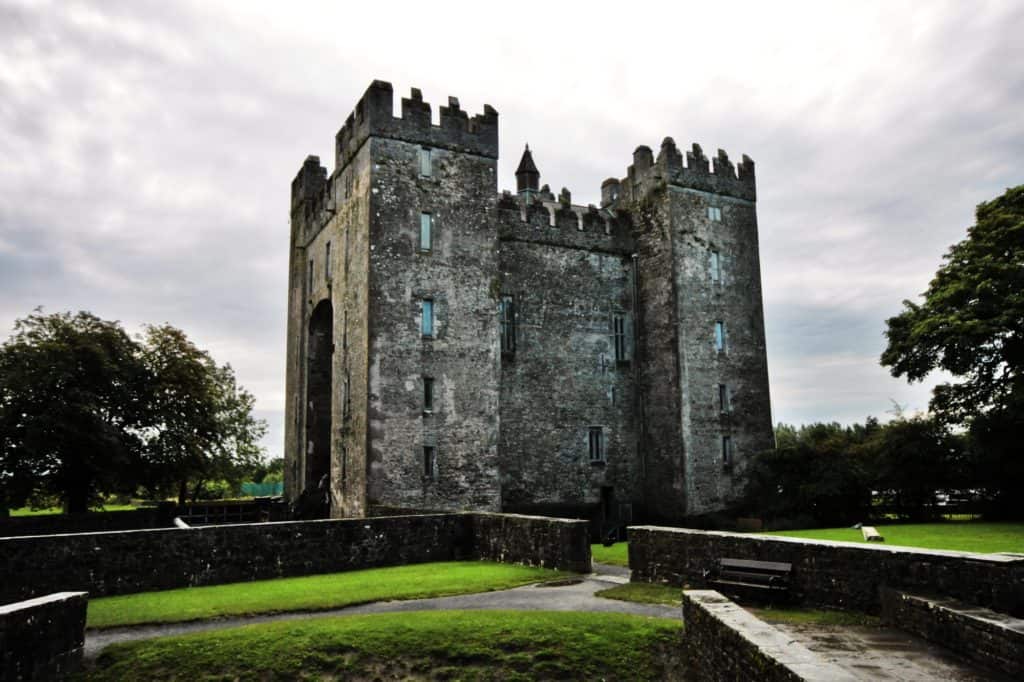
Bunratty Castle, meaning “Castle at the Mouth of the Ratty,” is a large 15th-century tower house in County Clare, Ireland. It is the most complete and authentic medieval fortress in Ireland. The castle and the adjoining folk park are considered tourist attractions.
The Norsemen were the first to settle in the area in 977. Around 1250, King Henry III of England granted the district of Tradraighe to Robert De Muscegros. In 1959, a hotel was constructed in the area.
These lands were later granted to Thomas De Clare, a descendant of Strongbow, in 1276. This castle was occupied for almost 50 years between the 13th and 14th centuries, after which it was destroyed. Later, it was rebuilt and became the focal point of several major battles.
The castle that can be seen nowadays was built by the MacNamara family after 1425. In 1558, Thomas Radclyffe, the Lord-Lieutenant of Ireland, took it from Donal O’Brien of Duagh, the last King of Thomond, and gave it to Connor O’Brien.
During the Confederate Wars, set off by the Irish Rebellion of 1641, Lord Forbes commanded the forces of the castle, which remained the property of the O’Briens until it was sold in 1712.
The Royal Irish Constabulary used the castle as a barracks during the mid-19th Century. In 1956, the 7th Viscount Gort purchased and restored the castle, saving it from ruin. The castle was opened to the public in 1960, featuring furniture, tapestries, and works of art dating back to 1600.
Nowadays, the castle, along with Bunratty Folk Park, is considered a major tourist attraction, and both are open to the public. The castle is famous for its medieval banquets, offered since 1963, at which the “Bunratty Castle Entertainers” perform today. Bunratty Folk Park is an open-air museum featuring around 30 buildings, including the Ardcroney Church of Ireland church.
Nestled in the heart of Bunratty’s historic countryside and within easy access to Shannon Airport, the Bunratty Castle Hotel is also available close to Bunratty Castle and Folk Park. It is also a great wedding venue.
The 30 houses and cottages at Bunratty Folk Park are a living recreation of Ireland in the 19th Century. The houses and shops in Bunratty Folk Park have been chosen from many different areas and recreated to form a collection of typical 19th-century urban Irish buildings. Not only that, but costumed characters also recreate the traditions and lifestyle of the olden days. While strolling around, you can also see a beautiful Walled Garden, modelled on the original Regency period garden, which supplied fruit, vegetables and flowers to Bunratty House. At night, impressive medieval banquets are held twice at Bunratty Castle.
The beautiful spectacle at the Irish castle will take you back to a time of knights, lords, and ladies. Visitors describe the experience as magical. When you first arrive at the Bunratty Medieval Castle Banquet, a kilted piper greets you. As you enter the great hall, you will be met with magnificent views of the beautiful tapestries and furniture dating back to the 16th Century as you savour a goblet of Mead. Then, a medieval Madrigal will inform you of the castle’s turbulent and exciting history.
You will also be able to witness the crowning of the Earl and Lady before descending to the Banquet Hall where bench seating, candle-light and long oak tables reflect the Banqueting style of the medieval era for a four-course dinner accompanied by Irish Harp and Fiddle. The performance continues as a scoundrel is revealed who must be brought before the Earl, who will decide his fate.
The entire experience seems magical and quite immersive for those interested in a taste of history and fine dining and anyone who wishes to spend an entertaining evening.
Caherconnell Castle
Caherconnell, meaning “Conall’s stone ringfort,” is a well-preserved medieval stone ringfort in County Clare, Ireland. It dates from the early 10th to the mid-12th Century.
Today, the ringfort is open to the public. Since 2010, the castle has established an archaeological field school where students can learn archaeological techniques from leading archaeologists.
Craggaunowen Castle
Craggaunowen is a 16th-century castle and an archaeological open-air museum in County Clare, Ireland.
Craggaunowen means Owen’s little rocky hill. Craggaunowen Castle was built by John MacSioda MacNamara circa 1550.
The castle was left in ruins in the 17th Century. In 1821, “Honest” Tom Steele, a confederate of Daniel O’Connell, “The Liberator,” inherited the Tower House, which was then transformed into a summer house for recreation.
John Hunt restored Craggaunowen Castle in the 1960s and established the open-air museum. The museum features reconstructions of ancient Irish architecture, including a dolmen, a crannog, and the currach boat used in Tim Severin’s recreation of “The Voyage of St. Brendan the Abbot.” It also shows reconstructions of a Ringfort, Fulachta Fia (a Bronze Age cooking and industrial site), and Standing Stone (Ogham Stone).
Check back constantly for more info about the rich history of Ireland!


